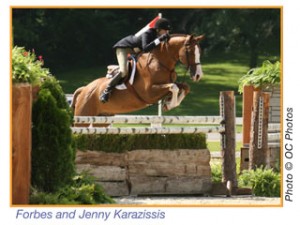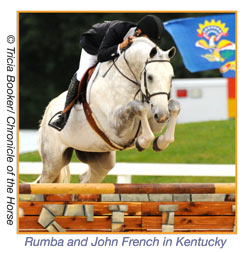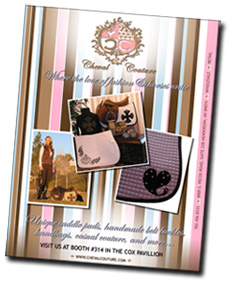Our Nation in Europe
On the International side of equestrian sport, the 2010 Meydan FEI Nations Cups Series is complete. With the riders chosen for the long list split into three Nations Cups tours, the United States had some stellar performances, including the all-girls team winning in Rotterdam and two second place finishes, one early on in La Baule and one at the last show in Dublin.
After all the points were tallied, the US slipped ahead of Great Britain finishing second overall with 44 points. A very commendable finish that those fifteen riders collectively achieved.

Less Than 40 Days Until the WEG
The Selection Committee has officially chosen a short list from the long list to represent the United States at the World Equestrian Games. And one name won’t be on it…
First we would like to congratulate the top four: McLain Ward/Sapphire, Laura Kraut/Cedric, Lauren Hough/Quick Study and Mario Desluariers/Urico as well as the ‘traveling substitute’ Candice King/Skara Glen’s Davos. Sitting in the fifth and sixth spots on the list are Richard Spooner/Cristallo and Rich Fellers/Flexible. Since there is over a month until the WEG begins, even if the order of the above names change slightly, they all had a fantastic showing in Europe and would certainly be solid representatives.
Note that one top name that has achieved consistent success since WEF is missing. She did very well throughout the WEG Trials at WEF and in Europe. She made the horse she rode an international name. We interviewed her recently; please read about her experience in Nicole Simpson On Tour. So why is her name not in the top six? The horse she rode so fabulously had to be withdrawn – he never returned from Europe.
Where is Tristan? A Commentary…
Although surprising, this sad situation brings to light a distinct truth about the sport at this level – the riders often don’t own the horses they ride. One would think that an owner with international aspirations is committed to the process from beginning to end. Could it be possible that a unique circumstance supercedes the original goals? If the process is going well and the horse and rider are competing successfully with a strong chance of making a national team, one would hope, even expect, that the owner would remain committed. Certainly the rider would, as this is a rider’s dream – representing their country on a gifted horse that they’ve developed into an international talent.
If the horse is at the top of his game, in Europe, and along comes a potential buyer or offer, what does an owner do? While one perspective would be to stick to the commitment made to the rider, the USEF and his or her fellow USEF long list owners, there are certainly many other considerations. Will Tristan show up at the WEG with a rider from another country and potentially under another name? Time will tell, and if he does compete, even with another rider and for another country, we should all take a moment to appreciate the world class riding and commitment that went into his development into an international competitor.
Of course during our interview we asked Nicki about Tristan’s plan after her successful tour. At the time she mentioned that she thought it odd that the horse had not yet returned, but we didn’t discuss details. Once she knew she had to withdraw the horse from the WEG selection, she called. We added her comments to the article.
 Friday was the big day – the first round of the finals. 60 horses qualified. To establish the order of go, they took the bottom 30 horses in the national rankings and randomly drew the first half of the class, followed by a random draw of the top 30 horses for the second half of the order. This ensured that someone like Jennifer Alfano and Jersey Boy, who won an award for the most money won during the qualifying season, would not have to go first. I drew 28th on Aragon and 50th on Forbes. Keri and John both went in the second half of the order. We were given the classic hunter course diagram that night.
Friday was the big day – the first round of the finals. 60 horses qualified. To establish the order of go, they took the bottom 30 horses in the national rankings and randomly drew the first half of the class, followed by a random draw of the top 30 horses for the second half of the order. This ensured that someone like Jennifer Alfano and Jersey Boy, who won an award for the most money won during the qualifying season, would not have to go first. I drew 28th on Aragon and 50th on Forbes. Keri and John both went in the second half of the order. We were given the classic hunter course diagram that night. This round was also a classic format but the four sets of judges could give up to 10 bonus points on top of their regular score for style and quality of movement. I had a rail down at one of the five option jumps. In hind sight I wish I had done the lower 3’6” option. I didn’t see Keri go but she said she had some difficulty at the squirrel tail jump. The second you exited the ring the media pulled you aside for an interview so I also missed John’s round but I could hear the crowd go crazy when it was over. His score was 400 including the bonus points!
This round was also a classic format but the four sets of judges could give up to 10 bonus points on top of their regular score for style and quality of movement. I had a rail down at one of the five option jumps. In hind sight I wish I had done the lower 3’6” option. I didn’t see Keri go but she said she had some difficulty at the squirrel tail jump. The second you exited the ring the media pulled you aside for an interview so I also missed John’s round but I could hear the crowd go crazy when it was over. His score was 400 including the bonus points! EQUESTRISOL AD DESIGNS
EQUESTRISOL AD DESIGNS